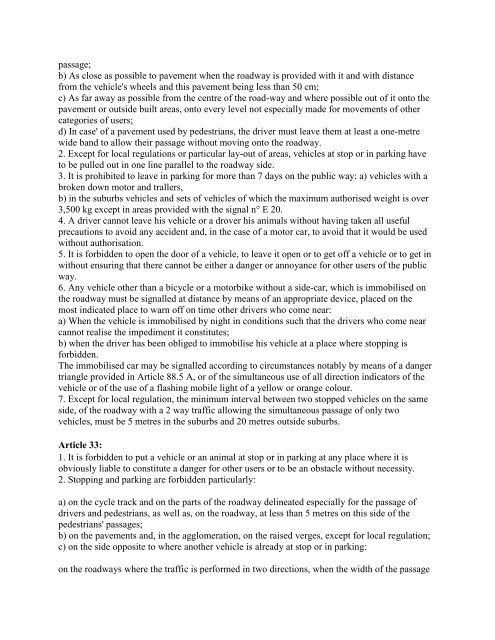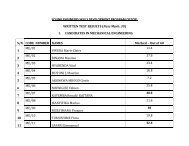lois et reglements police de roulage avec amendements
lois et reglements police de roulage avec amendements
lois et reglements police de roulage avec amendements
Create successful ePaper yourself
Turn your PDF publications into a flip-book with our unique Google optimized e-Paper software.
passage;<br />
b) As close as possible to pavement when the roadway is provi<strong>de</strong>d with it and with distance<br />
from the vehicle's wheels and this pavement being less than 50 cm;<br />
c) As far away as possible from the centre of the road-way and where possible out of it onto the<br />
pavement or outsi<strong>de</strong> built areas, onto every level not especially ma<strong>de</strong> for movements of other<br />
categories of users;<br />
d) In case' of a pavement used by pe<strong>de</strong>strians, the driver must leave them at least a one-m<strong>et</strong>re<br />
wi<strong>de</strong> band to allow their passage without moving onto the roadway.<br />
2. Except for local regulations or particular lay-out of areas, vehicles at stop or in parking have<br />
to be pulled out in one line parallel to the roadway si<strong>de</strong>.<br />
3. It is prohibited to leave in parking for more than 7 days on the public way: a) vehicles with a<br />
broken down motor and trallers,<br />
b) in the suburbs vehicles and s<strong>et</strong>s of vehicles of which the maximum authorised weight is over<br />
3,500 kg except in areas provi<strong>de</strong>d with the signal n° E 20.<br />
4. A driver cannot leave his vehicle or a drover his animals without having taken all useful<br />
precautions to avoid any acci<strong>de</strong>nt and, in the case of a motor car, to avoid that it would be used<br />
without authorisation.<br />
5. It is forbid<strong>de</strong>n to open the door of a vehicle, to leave it open or to g<strong>et</strong> off a vehicle or to g<strong>et</strong> in<br />
without ensuring that there cannot be either a danger or annoyance for other users of the public<br />
way.<br />
6. Any vehicle other than a bicycle or a motorbike without a si<strong>de</strong>-car, which is immobilised on<br />
the roadway must be signalled at distance by means of an appropriate <strong>de</strong>vice, placed on the<br />
most indicated place to warn off on time other drivers who come near:<br />
a) When the vehicle is immobilised by night in conditions such that the drivers who come near<br />
cannot realise the impediment it constitutes;<br />
b) when the driver has been obliged to immobilise his vehicle at a place where stopping is<br />
forbid<strong>de</strong>n.<br />
The immobilised car may be signalled according to circumstances notably by means of a danger<br />
triangle provi<strong>de</strong>d in Article 88.5 A, or of the simultaneous use of all direction indicators of the<br />
vehicle or of the use of a flashing mobile light of a yellow or orange colour.<br />
7. Except for local regulation, the minimum interval b<strong>et</strong>ween two stopped vehicles on the same<br />
si<strong>de</strong>, of the roadway with a 2 way traffic allowing the simultaneous passage of only two<br />
vehicles, must be 5 m<strong>et</strong>res in the suburbs and 20 m<strong>et</strong>res outsi<strong>de</strong> suburbs.<br />
Article 33:<br />
1. It is forbid<strong>de</strong>n to put a vehicle or an animal at stop or in parking at any place where it is<br />
obviously liable to constitute a danger for other users or to be an obstacle without necessity.<br />
2. Stopping and parking are forbid<strong>de</strong>n particularly:<br />
a) on the cycle track and on the parts of the roadway <strong>de</strong>lineated especially for the passage of<br />
drivers and pe<strong>de</strong>strians, as well as, on the roadway, at less than 5 m<strong>et</strong>res on this si<strong>de</strong> of the<br />
pe<strong>de</strong>strians' passages;<br />
b) on the pavements and, in the agglomeration, on the raised verges, except for local regulation;<br />
c) on the si<strong>de</strong> opposite to where another vehicle is already at stop or in parking:<br />
on the roadways where the traffic is performed in two directions, when the width of the passage




